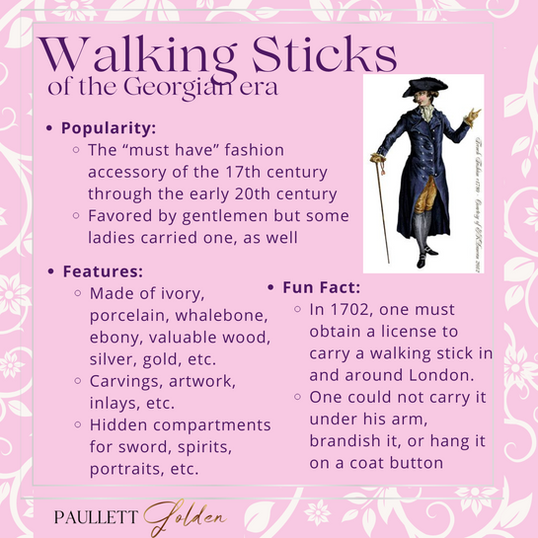Real People. Real Conflict. Real Romance.
Historical Romance
in the style of Jane Austen

Fashion: Walking Sticks
A glimpse of the fashion craze over walking sticks
Be it a walking stick, cane, staff, or hook, carrying one was the fashion accessory during the Georgian era.
Walking sticks were typically made of ivory, whalebone, ebony, or valuable wood but there were certainly a few unique ones, such as of bamboo, glass, porcelain, rattan, hardy reed, etc. While the most common choice was a stick of quality wood with a decorative handle, each person had a stylistic preference--how about Marie Antoinette, who preferred a Shepherd’s crook?
The trend began during the 17th century. No fashionable man would leave home without his walking stick. It was considered part of the daily attire, much like a cravat or stockings. Not to carry a stick was considered ill mannered (as well as undressed!), a violation of genteel manners, really. This trend did not lose traction until replaced by umbrellas in the early 20th century.
In 1702, gentlemen living in London needed to obtain a license to carry a walking stick or cane. The license permitted the bearer of the cane to walk with it through the streets of London and within ten miles outside city limits, but it had restrictions, as well. A gentleman was not allowed to carry the stick under his arm, brandish it in the air, or hang it on his coat button (which has been a popular trend during the earlier 17th century). If caught doing these, the stick could and would be confiscated (by the fashion police, one assumes).
Through the 17th century, this was a gentlemen’s fashion, but women began carrying them as a fashion accessory, as well, during the 18th century, although it did not catch on with women quite so well, so that by the Regency era of the early 19th century, only the gentlemen were left sporting the walking stick.
The sticks were rarely plain, usually fantastically bespoke with carvings, paintings, miniature portraits, and more. The stick itself could be the decorative feature, showcasing fanciful carvings or art, or it could be of quality hard wood with the handle of silver or gold, or the stick rather plain but featuring a decorative handle of intricate carving, art in glass, engraved gold, etc. The handle shape was another consideration, be it a derby, a knob, an animal, a fritz, etc. Some of the finest sticks could be designed uniquely, such as made of glass, of bone, of porcelain, of animal spinal columns, or even wrapped in animal skin.
It was not uncommon for the stick or cane to have hidden features or compartments, such as doubling as a pool stick, shielding a sword, hiding liquor, holding a portrait of a loved one, etc.
This visual history of walking sticks by Anthony Moss is not to be missed! https://antiquecanes.net/visual-history-walking-sticks-canes/
For the most detailed and hands down fantastically fabulous post you can read about this fashion accessory, from the different stylings all the way to some of the fun satire about stick bearers (are you a Twirler, an Arguer, or perhaps a Trailer?), check out this post by Geri Walton: https://www.geriwalton.com/walking-sticks/ (Seriously, don’t miss this post!)
